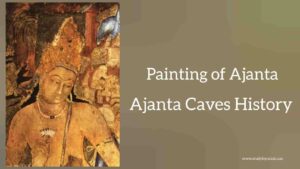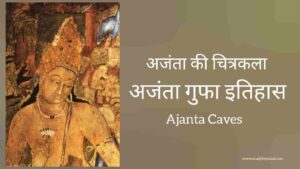Introduction to the art of Buddhist period
Today we will tell you about the painting of Buddhist period. Buddhist period art history in english – With the beginning of the AD century, the golden age seems to have started in the history of Indian art of “ancient period”. At this time Buddhism was also establishing its influence, and the public was also adopting Buddhism. This progress and prevalence of Buddhism continued well till the seventh century AD. By this time the Brahmin religion had not been able to achieve progress again, and at this time India was a prosperous country in the eastern countries. And the light of India’s knowledge and science was illuminating the whole of Asia. Entire Asian countries were looking towards Buddhist-India for religious inspiration and knowledge. At this time, a large number of tourists used to come from far and wide to visit the holy pilgrimage Kaushal all over India, and the teachings of Lord Buddha were being adopted in all the eastern countries. The knowledge and philosophy of the painting of this time is shown very deeply. Buddhism has greatly influenced the art of eastern countries such as Sri Lanka, Nepal, Java, Shyama, Brahma, Tibet, Japan and China. The remains of painting, sculpture and architecture of all these countries give proof of this.
बौद्ध काल की चित्रकला in hindi – “Click here”
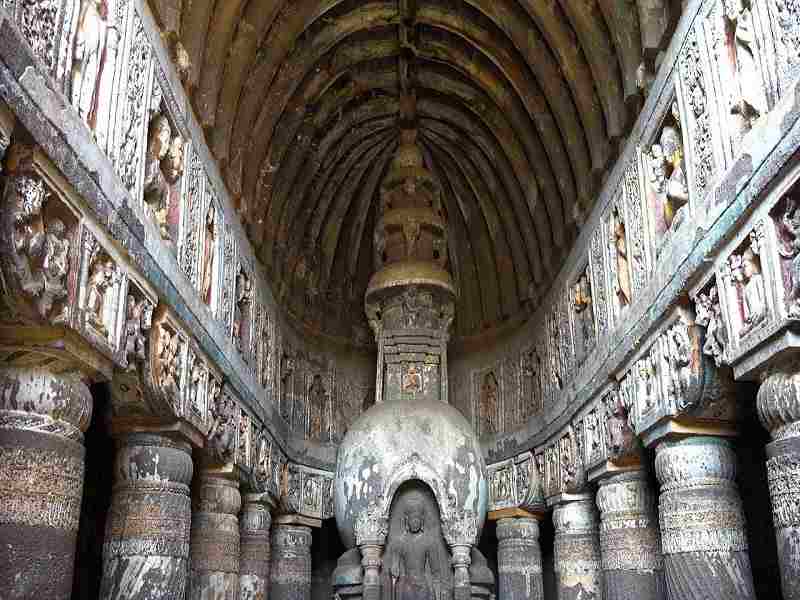
Art of Buddhist Period, Cave Temple Art, Painting, Ajanta Caves, Gandhara Style Painting, Bagh Caves Art, Ajanta Painting, Buddhist Period Painting until) Buddhist period art history in english (painting of cave temples – from 50 AD to 700 AD) , Painting of Buddhist period
Buddhist painting
Taranath was a 16th century Tibetan historian. Taranath has mentioned that wherever Buddhism spread, skillful painters have been found there. This thing can be seen specially in the painting of India. Many beautiful artworks have been absorbed in the cheek of time, it means that many paintings have been destroyed now. Nevertheless, some proper creations of Buddhist, Bhagwat and rock artists, hiding the saga of artist’s dexterity and efficiency of workmanship, are still available in good condition. Which is still well preserved. These skilled craftsmen have established a special style of painting. The art style of Buddhism was developed in a very natural way. Buddhism is exclusively pictorial.
Around 200 AD, the images or idols of Mahatma Buddha were not made under Buddhism in the early times. The practice of marking umbrella, crown, turban, Charan Paduka, Buddhist tree, Dharmachakra or throne etc. as their symbol to show the preaching of religion or the existence of Buddha became prevalent, but the image of Buddha was not marked. . Buddhist period history in english.
Where have Buddhist paintings been seen
- gandhara style
- Ajanta Caves
- tiger caves
- Badami Caves
- Sittananavasal Cave
- Sigiriya Caves
Prevalence of Buddhist image in Gandhara style
Mahayana (evolutionary sect) Buddhism started as soon as Kanishka became the emperor in the Kushan state. Due to this, the images of Lord Buddha started being written in the form of idols and pictures. And there is no religious restriction on marking Buddha. The idols of Buddha were made during the Kanishka period itself. These types of idols were made in Peshawar, Rawalpindi, Takshashila etc. areas and all these areas came under the limits of Gandhara state, hence this style is called as Gandhara style. The theme of these idols is Indo-Buddhist but the style has Greek and Roman influences. These artists made sculptures based on the story related to the life of Buddha and the Jataka story, and in these sculptures Buddha’s postures are Indian, such as – Abhaya Mudra, Gyan Mudra, Dhyana Mudra or Dharma Chakra Pravartana Mudra etc. But the clothes, costumes and decorations in these idols are foreign. Buddha had cut his hair before penance, but curly hair is visible in the “statue of Buddha absorbed in penance” by foreign artists of Gandhara style. This style was spread to Central Asia. Boudh kaal ki chitrakala in english.
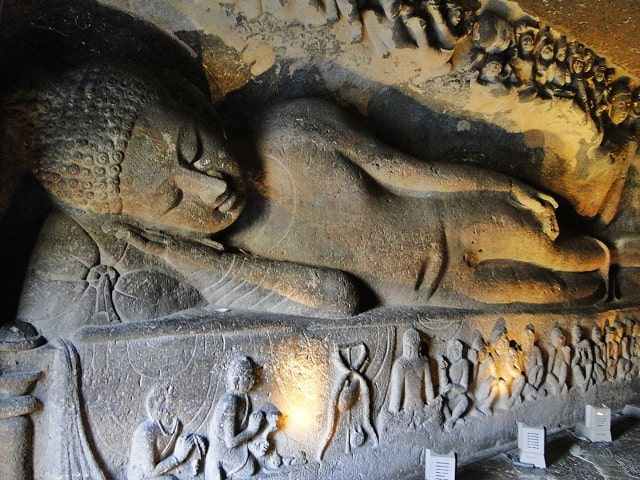
Prevalence of Buddhist art in Ajanta caves
Ajanta is located in Aurangabad district of Maharashtra. In each cave of Ajanta, sculptures, pillars and doors have been cut and painted on the walls (walls). Ajanta caves are a very good confluence of architecture, sculpture and painting. The subject of most of the paintings of Ajanta is related to Buddhism. These paintings include various images of Buddha and sacred religious symbols. Along with this, the life stories of Buddha’s birth and birth and Jataka stories are the main subjects of the paintings of these caves. Under the Jataka stories, there are stories of many previous births of Buddha, which have been depicted very beautifully by the painter. These are pictures of Jataka stories, this can be known on two grounds, first – the name of Jataka story is written on these pictures, but due to the destruction of the pictures, there is difficulty in recognizing the picture. And secondly, the Jataka story of the Paddanta elephant in the tenth cave and other Jataka tales can be identified because of the marking and their characteristics according to their events. The pictures of Buddha’s birth have also been shown in the Ajanta cave.
Tiger caves
The Bagh Caves were located in the Vindhyachal mountain range in the ancient Gwalior princely state, but after independence, these caves have come under Madhya Pradesh. The people there also call these caves by the name of Panch Pandav. Buddha’s pictures are also inscribed in the tiger caves, it is seen that 4 elephants and 3 horsemen have come to another place, the elephants have sat down to rest, there are 2 pedestrians with swords in their hands. Their attention is focused on the building in front. A blue cloth hangs from a mango tree nearby and water vessels and Dharma Chakra are shown below. There is also a banana tree near it, under which Buddha is sitting, and is depicted preaching to a disciple. There are many pictures of Gautam Buddha in the sixth cave, in which the beautiful picture of “Buddha” has only remained. History of Chitrakala of Boudh period.
Badmi Caves
Badami caves are located in Karnataka province near Aihole under Bijapur district. The best examples of craft and painting are preserved in the four cave temples of Badami. There are Buddhist paintings at many places in the caves of Badami.
Sittananavasal Cave
The cave of Sittanavasal is located in Padukottai near Tanjore under the state of Tamil Nadu in South India. Sittanavasal cave is a Jain temple. This temple has been built by cutting a rock. Earlier this cave temple was decorated with many pictures, but now the pictures are left only in the ceiling and on the upper parts of the pillars. The style of the paintings of Sittanavasal is similar to that of Ajanta. There is a view of a lake here, in which lotus flowers are in bloom. The figures of a fish, elephant, swan and 3 divine persons are painted in the middle of this lake. And all three of them are holding lotus in their hands.
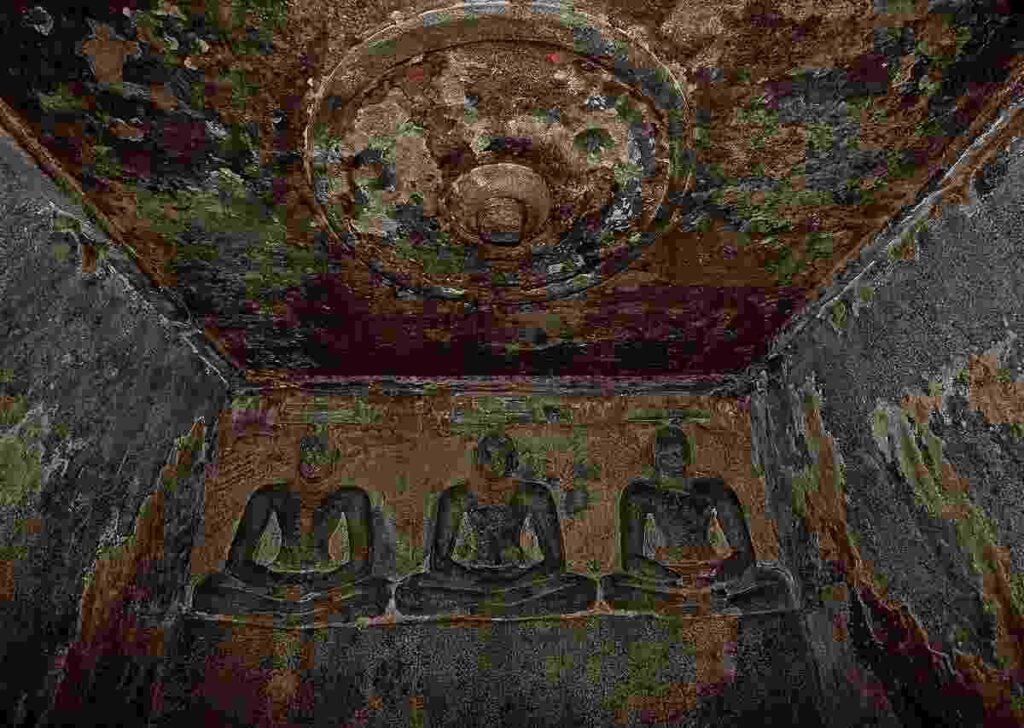
Sigiriya Caves
Indian Buddhist monks went to far eastern and southern countries for the propagation of religion, and along with them Indian painting, religion and philosophy etc. also reached those countries. Similarly, in Sri Lanka, the painting of Ajanta style of India reached with these religious preachers. Ajanta’s painting style is visible in the cave named Sigiriya in Sri Lanka. Similarly, pictures of Buddha are also inscribed here.
Other Evidence of Buddhist Paintings
- With the expansion of the power and empire of the Gupta kings, literature and art also developed. The Gupta kings did not impose any restrictions on Buddhism, but due to the conflicts between the Mahayana and Hinayana sects of Buddhism, Buddhism suffered a lot.
- At one place in Kapilavastu there was a depiction of a sacred belief, in which the Buddha was depicted entering the womb of his mother sitting on the back of Svet Gaj.
- Some evidence of painting has been completely destroyed due to the devastation caused by the invasions of Muslims.
- Some paintings which were made on hard rocks could not be destroyed.
- In some of the paintings of Ajanta, pictures have also been made by preparing the floor by making a wooden frame and filling it with plaster. This type of practice must have been prevalent in other places as well, but the pictures must have been destroyed due to the destruction of the wood.
- It appears from all these examples that the artists of that time were good building experts and good artists, who were endowed with divine powers.
FAQ section
Q. What is the history of Buddhist period painting?
Ans. With the beginning of the AD century, the golden age seems to have started in the history of Indian art of “ancient period”. At this time, Buddhism was also establishing its influence, and the public was also adopting Buddhism. With the beginning of the 1st century AD, the golden age appears to have started in the history of Indian art of “ancient period”. At this time Buddhism was also establishing its influence, and the public was also adopting Buddhism.
Q. What are the paintings of Buddhist period?
Ans. Skilled painters have been found wherever Buddhism spread. This thing can be seen specially in the painting of India. Many beautiful artworks have been absorbed in the cheek of time, it means that many paintings have been destroyed now. Nevertheless, some proper creations of Buddhist, Bhagwat and rock artists, hiding the saga of artist’s dexterity and efficiency of workmanship, are still available in good condition. Which is still well preserved.
Q. Where is the Buddhist painting?
Ans. Gandhara Style, Ajanta Caves, Bagh Caves, Badami Caves, Sittanavasal Cave, Sigiriya Caves.
Q. How is the Buddhist art in Ajanta caves?
Ans. Ajanta is located in Aurangabad district of Maharashtra. In each cave of Ajanta, sculptures, pillars and doors have been cut and painted on the walls (walls). Ajanta caves are a very good confluence of architecture, sculpture and painting. The subject of most of the paintings of Ajanta is related to Buddhism. These paintings include various images of Buddha and sacred religious symbols. Along with this, the life stories of Buddha’s birth and birth and Jataka stories are the main subjects of the paintings of these caves.
Q. What is Gandhara style?
Ans. Mahayana (evolutionary sect) Buddhism started as soon as Kanishka became the emperor in the Kushan state. Due to this, the images of Lord Buddha started being written in the form of idols and pictures. And there is no religious restriction on marking Buddha. The idols of Buddha were made during the Kanishka period itself. These types of idols were made in Peshawar, Rawalpindi, Takshashila etc. areas and all these areas came under the limits of Gandhara state, hence this style is called as Gandhara style. The theme of these idols is Indo-Buddhist but the style has Greek and Roman influences.
See also
Art of Indus Valley Civilization – Painting in English – ” Click here “
Art and Civilization of the Pre-Buddhist Period in English – “ Click here “
Jogimara Cave and Art in English – ” Click here”

